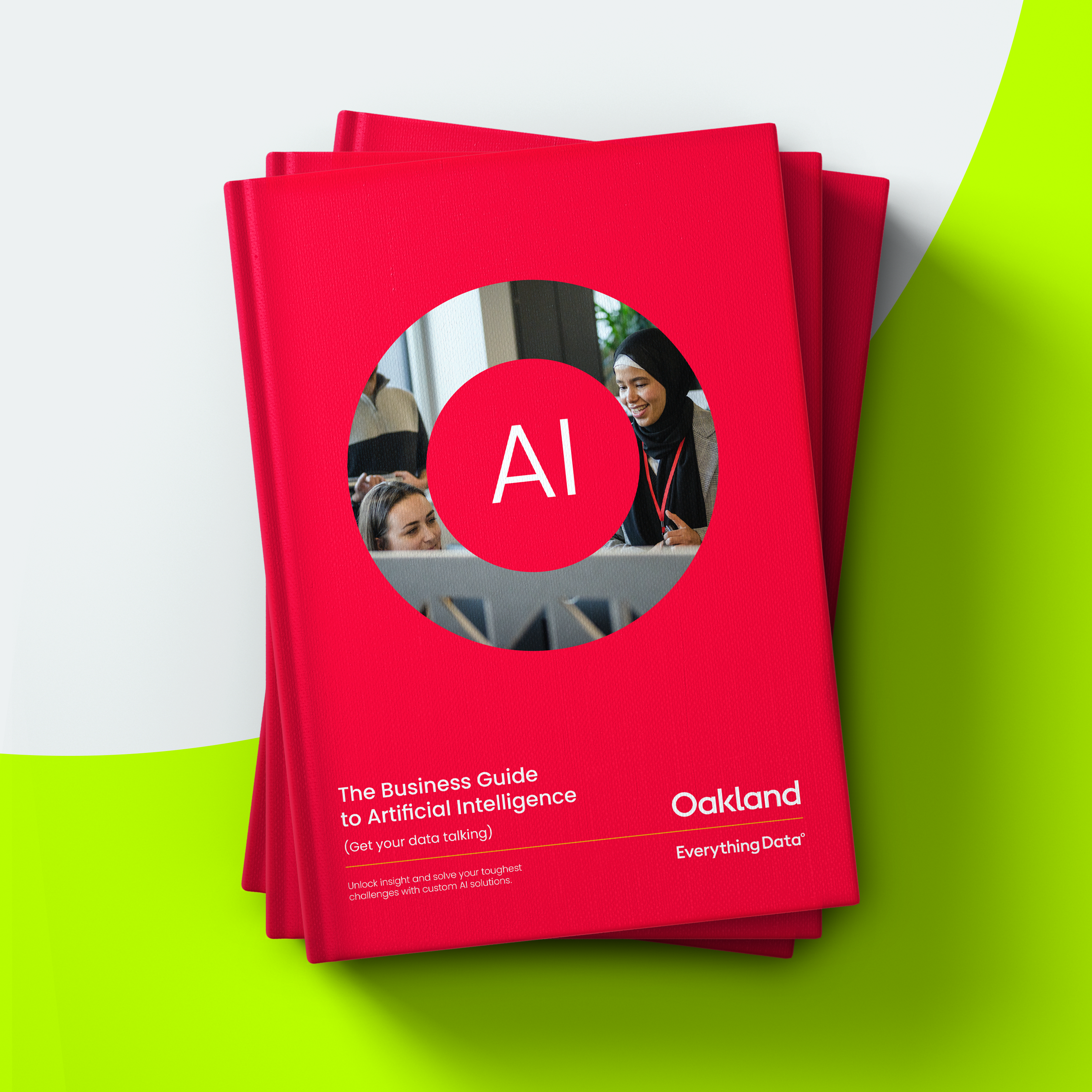How can you put AI to work in your business?
Businesses investing in AI technologies are spoilt for choice. There’s a huge array of powerful technologies with new ones hitting the market almost daily. AI models and services like Chat GPT, Co-pilot and Azure Cognitive Services are some of the biggest names.
But what do they do? Which AI technologies are right for your firm? How do you implement them and ensure you get value? And how do you sensitively integrate this new technology with your existing technology, people and processes?
Book Your AI Workshop Today“The deployment of generative AI capability within the learning from lessons library will transform the way we harness knowledge, enrich insights, and encourage cross-industry learning.“
Mo Momodu, Programme Manager of Rail Infrastructure Centre of Excellence

AI has the potential to transform your business. Contact our experts today and start your journey.
Get in touchFAQs
What is Artificial Intelligence?
AI involves using algorithms and software to carry out tasks that typically require human intelligence, such as understanding natural language, recognising patterns in data, and making predictions or decisions based on data.
A key aspect of AI is machine learning (ML); using computer algorithms and data to allow AI systems to learn things and use these learnings, and new data, to become more accurate.
AI and ML have been in use for decades. However, recent developments have fuelled accelerating awareness and adoption:
- Availability of algorithms: Advances in algorithms allow AI to perform thought-like tasks with greater accuracy, from image and speech recognition to natural language processing and decision-making.
- Data volume and velocity: The digitisation of many aspects of life and business resulted in a huge increase in data availability, which provided fuel for AI.
- Cloud computing: The cloud has made accessing powerful computing resources and large storage capacities on demand easier and more affordable, lowering the barrier to AI adoption.
- Commercial applications (and ROI): With the advent of commercially affordable and accessible AI services (e.g., ChatGPT, Google Gemini, Azure Cognitive Services), the adoption and interest in AI have exploded. Moreover, far more businesses are beginning to showcase tangible gains.
- Data and IT transformation: AI is only possible with the right data, strategy and infrastructure. As more leaders have invested in IT modernisation, integrating AI into operations has become a natural progression.
What is Generative AI?
Recently, large language models (LLMs) such as Chat GPT have gained huge publicity. LLMs represent a huge advance in AI’s ability to process and interpret natural language. This allows them to work with far less structured data, such as free text, and cope with far more ambiguous instructions than previous generations of AI.
Powered by LLMs or other technologies such as computer vision, the latest generation of AI can perform a wide range of repeatable, thinking-based tasks that previously required humans to complete them. This opens up a wide range of new possibilities for businesses to improve their performance and productivity.
Find out how to drive ROI with generative AI in our handy guide.
What is an Intelligent Agent?
Intelligent Agents are AI programs powered by large language models, but further equipped with tools, task orientation and careful training. This means they can reason, letting them interpret, plan and execute complex tasks, even in fast-moving business environments.
Intelligent Agents can bring powerful AI capabilities to the heart of your challenges without distorting processes to accommodate them. With Intelligent Agents, organisations can build ‘process native’ AI solutions that are at home in their business’s pace and complexity. This means they will realise lasting value from the solutions.
Read our guide to learn more about our intelligent agent approach.
How do I ensure a successful AI project?
AI projects can be daunting, but our experts find the following steps can greatly improve your chances of success.
Step 1: Carefully consider the problem you want to solve
Focus on acknowledged issues: Look for problems your organisation already recognises and wants to solve.
Target tasks with high impact: Identify repetitive tasks that affect many people.
Consider data availability: Make sure your organisation has the data and process information required for your chosen problem.
Step 2: Clearly define the problem
Precise articulation is key: Be specific about the problem you want AI to address.
Technical expertise matters: Collaborate with technical specialists to ensure your solution is feasible and uses the right AI approach.
Step 3: Think beyond the problem
Solution matters as much as the problem: Consider how you want AI to solve your problem. Would a simple Q&A solution suffice? Or is a more in-depth approach needed for a real impact?
Imagine the “human” solution: Ask yourself, “How would I tackle this problem if I weren’t using AI?” This can guide you towards a more meaningful solution strategy.
What are the hurdles to implementing a successful AI project?
Whilst GenAI is genuinely ground-breaking and not just another new technology on Gartner’s hype cycle, it’s also not quite as easy as it sounds. Many of the clients we speak are thinking about their first GenAI project, or they might even have done a proof of concept by combining some of their data with some off-the-shelf AI tools.
This is great; it generates some excitement and gives everybody a demo that starts to bring to life the power of AI to your stakeholders. But questions quickly follow:
- What next?
- What is the ROI?
- How am I actually going to make a difference with this?
- How am I going to get value out of this technology?
It’s all too easy to get dragged into what Oakland calls the ‘proof of concept trap’. This happens when organisations get their first projects out there, and people start to become excited, but then that initial buzz of excitement starts to fizzle out. And then we almost go back to the start of that cycle. You have another idea you do another proof of concept. Everyone gets really excited, and then it fizzles out again.
This technology is really powerful, but a lot of companies aren’t making that next step, where they are really getting value and making a difference for their customers. So you need to look at the preparedness of the AI for working in your organisation. Your business is unique; you have your own process, your own challenges, and your own complexity.
So, really, the question that we’ve been thinking about here at Oakland is how do we get AI ready for you because your business is complicated, and you can’t wait for a huge digital transformation to get yourself ready for AI.
How to avoid getting stuck at the POC Level
This is so common in the organisations we speak to, and we believe there are two main reasons behind it:
1: The imagination gap
Think deeply about the capability of the AI solutions that you’re building. If we put this into a human context, chatbots are a really powerful example of how AI can be put to work, but they’re just one example of a huge range of tasks that might exist in a business.
If you think about it, you have a new employee who joins, reads all of your documentation, and then sits slumped in the chair until you ask them a question. If they answered that question and then slumped back in their chair you wouldn’t be particularly impressed with their performance.
The same is true of AI – it can do a lot more than you might think.
At Oakland, we’re really serious about activating AI’s potential in a commercial context. We encourage all of our clients to ask, ‘How is it going to make a difference for me?’ That’s not to say there isn’t a powerful place for chatbots in service environments, but if you want to get to the big stuff and move the dial on the big problem your business is facing, you need to think beyond the chatbot.
2: Giving your AI knowledge and influence
The knowledge you equip AI solutions with and the influence you give them translate into their effectiveness. Things like the task orientation you create around them and the way you train and educate people to use them can matter hugely.
This all boils down to people, processes, and technology. We know in our own lives that the technology that fits most seamlessly into what we’re doing is the technology we adopt. If technology generates friction, it generates frustration, then ultimately gets ignored.
We also need to consider what the opportunities for your business are and where the value lies. After all, we’re all in the business of making money.
Your mountain of unstructured data is crucial to finding this value. According to Gartner, 80-90% of the data that businesses hold is unstructured. It’s not in rows or columns, in a data warehouse or spreadsheets, or in audio files, free text, images, and photographs.
Instead, it’s all the data you have: safety reports, customer feedback, email correspondence, and more. Your insights are all here, but it’s just been too expensive and time-consuming to analyse them properly.
Suddenly, with AI you have these almost endlessly scalable virtual workers that you can use to access that data. If you can unlock this data, you can make huge gains.
Work out what business problems are costing you time, money, and customers. This isn’t the next blockchain – it’s much bigger. The capability that’s on offer is like nothing we’ve had access to before in a commercial environment. But you have to use it in meaningful ways to solve real problems.
What business challenges can AI solve?
AI is poised to solve countless challenges businesses face today. We find they boil down to three areas – unlocking knowledge stores, scanning high-volume alarm and alert information, and unlocking insights from data. Here are some of the use cases we’ve worked on for our clients :
-
- Cost control: Understand your supply chain better, identify disruptions and inventory changes quicker, and then act faster and smarter to solve problems as they arise. Then, with AI-enabled demand forecasting, solve future problems before they materialise.
- Knowledge management: Combining ‘lessons learned’ documents, incident reports, policies, guidelines, and project updates in one place, AI can be used to categorise and summarise sources of enterpriseknowledge. Users can then access this information using a conversational interface, broadening the access and use of this valuable data.
- Product development: Improve the speed and effectiveness of product development with AI by gathering and summarising customer feedback and market insights, then quickly and seamlessly putting them into action.
- Fraud detection: Monitor your customers and accounts, flag suspicious activity, and automatically stop anomalous activity before it can harm your business.
- Customer experience: With AI-trained customer support systems, customer service staff and chatbots can learn more about customer problems faster. They can also ably handle unstructured complaint and feedback data, reading, summarising and categorising it to handle feedback at scale. All this helps businesses serve up more valuable support, 24/7.
- Asset management: Gain a bird’ s-eye view of the vehicles, machinery, and equipment used across your entire operation. AI can monitor how regularly they’re used, chart this against component and machine lifespans, and flag when maintenance is required, letting you act before the costly shutdown.
- Understand your customers: With AI-augmented customer segmentation, predictive analytics, and personalisation, generate smarter insights you can feed into more effective campaigns.
Find out more about generative AI use cases for enterprise in our expert guide.







